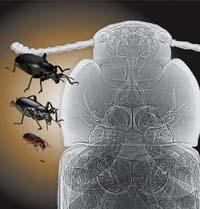Limit of giant beetles

The largest beetle species in the world is the Titanus giganteus of the Amazon rainforest, with an average male size of 13.5 cm and almost 17 cm (excluding antennas). They are galantas, but there was a time when the beetles were much older, in the late Paleozoic. How did these giant insects disappear? To answer this question, researchers at the Argonne laboratory investigate where the insect size limit is and what it depends on.
Through X-rays, they observe the interior of four species of beetle of very different sizes. And they have seen that the largest have a higher proportion of tracheal tubes than the small ones -- they are structures that use to transport oxygen to all parts of the body. According to these researchers, the size of beetles is mainly limited by the tracheal tubes of the legs, and according to the calculations made, the largest size that the beetle can have is the one that has the Titanus giganteus.
Then, how did beetles live larger than they? For the explanation is in the oxygen of the air: In the late Paleozoic, the air had more oxygen than now, making it easier to expand into the body of the beetle.





